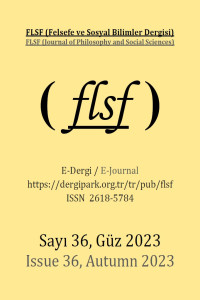Abstract
Matematik ve matematiksel nesnelerin doğası, kadim zamanlardan beri insanların ilgisini çekmiş bir alandır. Ancak matematiğin hayatımızdaki önemi ortada olmasına karşın sayıların ve şekillerin gerçekten ne olduğunu ve nereden geldiğini tam olarak açıklayabilmiş değiliz. Öte yandan, matematiğin doğayla ve dolayısıyla doğa bilimleriyle olan ilişkisi göz önüne alındığında matematik ile doğa bilgisi arasındaki gizem de henüz tam anlamıyla çözülmüş değildir. Pisagor’dan Öklid’e ve Eflatun’a kadar uzanan yelpazede birçok Antik Yunan filozofu, matematiksel nesnelerin doğası üzerine fikir beyan etmiştir. Benzer bir biçimde, matematiksel nesneler, Ortaçağ’da hem Hıristiyan ve hem de Müslüman filozofların dikkatini çekmiştir. Ama Batı felsefe tarihinde matematiksel nesnelerin ontolojik statüsü konusunda en sistematik yaklaşımı ve çözüm denemesini, kanaatimizce, Kant ortaya koymuştur. Ne var ki, Kant da çok uğraşmasına ve aslında doğru kaynağı işaret etmesine karşın matematiksel nesneleri, ne yazık ki, tatmin edici bir biçimde tesis edememiştir. Öbür taraftan, son zamanlarda matematiksel nesnelerin kaynağına dair son derece ufuk açıcı yepyeni bir görüşün ortaya çıktığını görmekteyiz. Bahsettiğimiz bu görüş, Anadolu’nun son zamanlarda yetiştirdiği en büyük düşünürlerden biri olan Yalçın Koç’un görüşüdür. Koç, matematiksel nesnelerin kaynağını ve doğasını yepyeni bir perspektifle ele alarak onların ancak ‘nazariyat’ (theoria) adını verdiği aşkın dil/dünya temelinde açıklanabileceğini öne sürer. Biz de bu makalede, Koç’un matematiksel nesnelerin kaynağının ne olduğu, nasıl var oldukları ve doğayla nasıl bir ilişki içerisinde oldukları görüşünü, onun ‘nazariyat’ ve ‘arkitektonik dil’ anlayışı temelinde irdelemeye çalışacağız.
References
- HUME, David. A Treatise of Human Nature, ed. L. A. Selby-Bigge ve P. H. Nidditch, 2. baskı, Oxford: Oxford Univ. Press, 1978.
- JONES, Edwin. Reading the Book of Nature, Atina: Ohio Univ. Press. 1989.
- KANT, Immanuel. Critique of Pure Reason, İng. çev. N. K. Smith, New York: St. Martin’s Press. 1965.
- KANT, Immanuel. Logic, İng. çev. R. S. Hartman ve W. Schwarz, New York: Dover Pub., 1988.
- KANT, Immanuel. Prolegomena, İng. çev. P. Carus, 13. Baskı, Chicago: Open Court, 1996.
- KOÇ, Yalçın. Anadolu Mayası, 3. Baskı, Ankara: Cedit Neşriyat, 2011.
- KOÇ, Yalçın. “Mekân ve Nesne”, Felsefe Arkivi, 29, 1994.
- KOÇ, Yalçın. “Matematiğin Ontoloji Bakımından Kant ile Frege Karşılaştırması”, Felsefe Arkivi, 36, 1996.
- KOÇ, Yalçın. Teographia’nın Esasları, Ankara: Cedit Neşriyat, 2009
- KOÇ, Yalçın. Teologia’nın Esasları, Ankara: Cedit Neşriyat, 2008.
- YALÇIN, Şahabettin. “Kant’ta Matematiğin Felsefi Temelleri”, Felsefe Dünyası, 37, 2003.
Abstract
Although the importance of mathematics in our lives is obvious, we have not been able to fully explain what mathematical objects really are, and where they come from. On the other hand, considering the relationship of mathematics with nature and therefore with natural sciences, the mystery between mathematics and natural science has not been fully resolved yet. Many Ancient Greek philosophers, ranging from Pythagoras to Euclid and Plato, expressed their opinions on the nature of mathematical objects. Similarly, mathematical objects attracted the attention of both Christian and Muslim philosophers in the Middle Ages. But, it may be argued that in the history of Western philosophy Kant had put forward the most systematic approach to the ontological status of mathematical objects. However, though Kant moved in the right direction on this issue, and did a really good job to construct the mathematical objects, we cannot say that he was really successful here. Recently, the Turkish philosopher Yalçın Koç has put forward a totally new approach as to the source and nature of mathematical objects. According to Koç, mathematical objects could only be explained on the basis of a transcendent language/world which he calls 'theoria'. In this article, I try to examine Koç's view regarding the source and the nature of mathematical objects on the basis of his concept of 'theoria' and 'architectonic language'.
Keywords
References
- HUME, David. A Treatise of Human Nature, ed. L. A. Selby-Bigge ve P. H. Nidditch, 2. baskı, Oxford: Oxford Univ. Press, 1978.
- JONES, Edwin. Reading the Book of Nature, Atina: Ohio Univ. Press. 1989.
- KANT, Immanuel. Critique of Pure Reason, İng. çev. N. K. Smith, New York: St. Martin’s Press. 1965.
- KANT, Immanuel. Logic, İng. çev. R. S. Hartman ve W. Schwarz, New York: Dover Pub., 1988.
- KANT, Immanuel. Prolegomena, İng. çev. P. Carus, 13. Baskı, Chicago: Open Court, 1996.
- KOÇ, Yalçın. Anadolu Mayası, 3. Baskı, Ankara: Cedit Neşriyat, 2011.
- KOÇ, Yalçın. “Mekân ve Nesne”, Felsefe Arkivi, 29, 1994.
- KOÇ, Yalçın. “Matematiğin Ontoloji Bakımından Kant ile Frege Karşılaştırması”, Felsefe Arkivi, 36, 1996.
- KOÇ, Yalçın. Teographia’nın Esasları, Ankara: Cedit Neşriyat, 2009
- KOÇ, Yalçın. Teologia’nın Esasları, Ankara: Cedit Neşriyat, 2008.
- YALÇIN, Şahabettin. “Kant’ta Matematiğin Felsefi Temelleri”, Felsefe Dünyası, 37, 2003.
Details
| Primary Language | Turkish |
|---|---|
| Journal Section | Research Article |
| Authors | |
| Publication Date | November 27, 2023 |
| Submission Date | July 19, 2023 |
| Acceptance Date | October 25, 2023 |
| Published in Issue | Year 2023 Issue: 36 |
Starting from 2024, our journal will be published in 3 issues as two regular and one special issues. These issues will be published In May (regular issue), September (special issue) and December (regular issue).
Only articles within the scope of the file will be included in our special issue.
Thank you for your attention.

